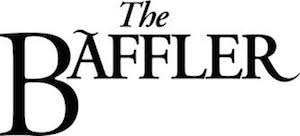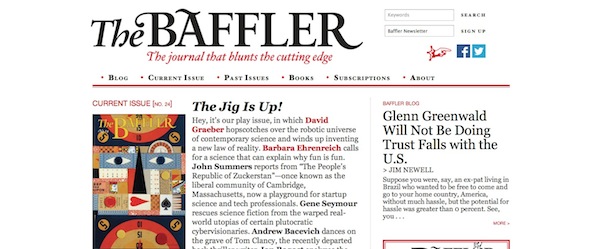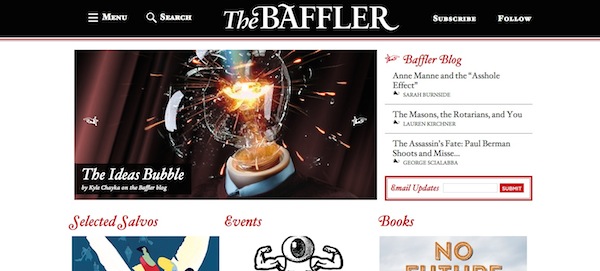
John Summers is responsible for the second life of The Baffler, which relaunched in 2012. The Baffler was a zine founded in 1988 by Thomas Frank and Keith White at the University of Virginia that grew up into a sort of anti-academic journal in Chicago. The publication, already hard to find, went on hiatus for a few years in the early 2000s,1 until Summers, sick of academic life, moved the publication to Cambridge with his family, jumpstarting the operation via a Kickstarter that ultimately raised just over $20,000. The magazine is known for its angry salvos and leftist rage, but also publishes original works of art and poetry.
 Today, The Baffler — a nonprofit — is published by MIT Press, which provides some funding for the magazine. When he started the job, Summers told MIT he didn’t want to know how many subscribers he had until he was above 25,000, the approximate circulation of the magazine in the 1990s. That hasn’t happened yet.
Today, The Baffler — a nonprofit — is published by MIT Press, which provides some funding for the magazine. When he started the job, Summers told MIT he didn’t want to know how many subscribers he had until he was above 25,000, the approximate circulation of the magazine in the 1990s. That hasn’t happened yet.
The majority of Baffler funding comes from individual donations, in addition to minor revenue from ads, newsstand sales (it’s available in around 500 bookstores), and merchandise. Summers has eschewed funding from foundations, which he says give people “enough money to say they gave you money.” Per MIT, The Baffler can sell ads in the back half of the book in print, where Summers says they print a single ad for Bookforum. They don’t sell ads online.
 With those funds, The Baffler employs five full-time staffers and four part-timers. Summers’ long term goal is a staff of 15. For now, though, staffing is tight — for example, while Summers thinks comments would be an interesting arena for readers to interact, he’s unwilling to take the plunge without the means to hire a moderator.
With those funds, The Baffler employs five full-time staffers and four part-timers. Summers’ long term goal is a staff of 15. For now, though, staffing is tight — for example, while Summers thinks comments would be an interesting arena for readers to interact, he’s unwilling to take the plunge without the means to hire a moderator.
The magazine also pays contributors a small fee for writing. What they absolutely do not do is have interns — The Baffler has had a strict No Intern policy since its founding, on the grounds that the internship system privileges those who are already privileged and disadvantages would-be publishing career havers who are not. “It’s a leisure-class activity,” Summers says of publishing.
But the biggest investment the magazine has made lately is its brand new website. When Summers started at The Baffler, he says he didn’t even know what a CMS was, so it took a while to understand that the old website was running on the entirely wrong type of software.

Eventually, he realized the magazine needed something that better fit The Baffler’s publishing schedule, which involves a roundup blog called Daily Bafflements plus regular guest posts online, in addition to longer magazine pieces. (The new site runs on WordPress.)

For Summers, the biggest problem with building a website is the way the Internet unbundles content, breaking up the continuity of an issue — something that, as editor, he spends a lot of time thinking about. “When you put it on the web, it comes apart,” he says. To resolve that issue, the new site uses digital platform publisher Issuu that allows readers to flip through the virtual pages of the magazine.
 The new design is purposefully more visual, incorporating The Baffler’s unique design style. Summers calls Patrick Flynn’s art direction “individualistic and idiosyncratic,” and says its a major element of the magazine’s identity and the relaunch.
The new design is purposefully more visual, incorporating The Baffler’s unique design style. Summers calls Patrick Flynn’s art direction “individualistic and idiosyncratic,” and says its a major element of the magazine’s identity and the relaunch.
But the flashiest part of the website launch is searchable, digital access to all of the The Baffler’s archives — “all 25 issues and 1,342,785 frequently snarling words” according to The New York Times. Summers wanted the website to be a place where even people who had never heard of The Baffler could come and get a sense of the magazine — an “un-fractured place to find out what The Baffler is,” in his own words. Freeing the archives and letting new readers get a taste of the publication’s roots is a way to do that.
 Little magazines gone digital: How the late-adapting literary press has made its way in the web agen+1: Learning that print and digital can peacefully coexistJacobin: A Marxist rag run on a lot of petty-bourgeois hustleThe Baffler: The anti-innovation magazine embraces digitalThe New Inquiry: Not another New York literary magazineA conversation with David Rose, little magazine veteran and publisher of Lapham’s QuarterlyMcSweeney’s Meets Internet: A little publisher survives holding tight to its eclectic, literary roots
Little magazines gone digital: How the late-adapting literary press has made its way in the web agen+1: Learning that print and digital can peacefully coexistJacobin: A Marxist rag run on a lot of petty-bourgeois hustleThe Baffler: The anti-innovation magazine embraces digitalThe New Inquiry: Not another New York literary magazineA conversation with David Rose, little magazine veteran and publisher of Lapham’s QuarterlyMcSweeney’s Meets Internet: A little publisher survives holding tight to its eclectic, literary rootsNot all of The Baffler’s content is free, though. New articles and archived pieces are subject to a metered paywall — non-subscribers can read 10 free articles before it kicks in. Giving the work away for free is a little counterintuitive for a publication as curmudgeonly as The Baffler. After all, the magazine’s slogan is “the journal that blunts the cutting edge,” and its editors renounce anything intended to obscure the capitalist nature of our society. “Innovation is an ideology,” Summers likes to say, as well as “Storytelling sells.” He believes that the new media industry is a distraction and dismisses it as “cheerleading,” complaining that “journalism isn’t for anything anymore,” a view that’s vividly on display in a recent post on the website.
Given all of that, The Baffler might be expected to have a digital strategy more in keeping with that of Harper’s — “Fuck the Internet.”
But despite its skepticism, The Baffler has decided to embrace its new web identity, to allow some of its carefully wrought commentary to make its way freely across the web. Prestige alone is not enough, Summers decided, if you want your words to have an impact.
“Would I continue to write 5,000-word pieces if I couldn’t send a link to my friends?” he asks. “No, I would not.”
Correction: This story originally said Summers was working at Harvard in 2012 when The Baffler relaunched; he had stopped teaching there in 2008.